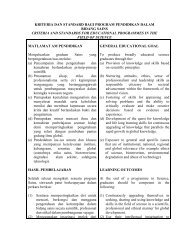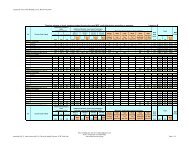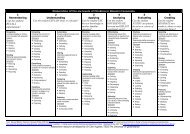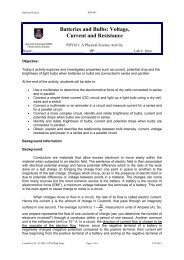Basic Physics II Evidences - DrJJ - UiTM
Basic Physics II Evidences - DrJJ - UiTM
Basic Physics II Evidences - DrJJ - UiTM
Create successful ePaper yourself
Turn your PDF publications into a flip-book with our unique Google optimized e-Paper software.
Material Science PHY407 Lab #2Activity 2.1:Configure the charges as in Figure 2.1a followed by charges in Figure 2.1b using the PhETsimulation ( Electric Field Hockey). Draw the forces you observed acting on the charge in themiddle of the configuration (the puck or hockey ball). Then draw the direction of motion youobserved.Prediction 2.2:1. Draw your prediction of the horizontal component for the force pulling or pushing aparticle due north along the positive y-axis and the vertical component for the forcepulling or pushing the same particle due west along the negative x-axis shown in Figure2.2a. The, draw your prediction for the resultant force in Fig 2.2a2. Draw your prediction of the horizontal and vertical components for each of the forcesshown in Figure 2.2b. Then draw the prediction for the sum of the horizontal and the sumof the vertical forces. Finally, draw your prediction for the resultant force in Fig 2.2b.Case1PredictionObservationCase2Fig 2.2a Fig 2.2aFig 2.2b Fig 2.2bActivity 2.2:Configure the forces in Figure 2.2a followed by the forces in Figure 2.2b using the PhETsimulation (from the PHET-Vector-Math). Then reveal the horizontal and vertical forces foreach of the force in Figure 2.2 by clicking on the button style 1 or style 2. Record the anglesbetween the components and the individual force. Then reveal the sum of the forces alongthe horizontal and along the vertical. Finally reveal the resultant force for each case.Compare these to your predictions.Questions1. Does a force pointing along the x-axis have any vertical component?2. Does a force pointing along the y-axis have a horizontal component?3. If a force is not acting along the horizontal or vertical direction, what should you do tothe force if you need to determine a resultant force if there is more than 1 force actingon a particle?4. How do you find the horizontal and vertical components for each force respectively?Created by Dr. JJ, FSG, <strong>UiTM</strong> Shah Alam Page 7 of 17 Last updated 17 th Jan 2010
















